SAR Radiometric Calibration Based on Differential Geometry: From Theory to Experimentation on SAOCOM Imagery
Abstract
1. Introduction
- (i)
- Providing novel insights into the differential-geometry-based SAR image radiometric calibration method [10], thus clarifying the meaning of its general formulation and, accordingly, providing an original interpretation of the method’s analytical expression, thus shedding new light on the inherent area-stretching function-based formalism [10];
- (ii)
- Developing a software prototype to systematically process the data acquired by the SAOCOM sensor, thus extending the usability of the original method implementation;
- (iii)
- Providing a quantitative analysis of the effectiveness of the adopted methodology, through an experimental investigation conducted over a significant mountainous region using the data acquired by the recently launched SAOCOM satellite’s SAR sensor.
2. Theoretical Background
3. Geometrical Interpretation of the Area-Stretching Function-Based Formalism
3.1. Azimuth-Invariant Topography Elevation Case
3.2. Canonical Flat-Earth Case
4. Experimental Investigation
4.1. Implementation of a Prototype for SAOCOM Images Processing
4.2. Study Area and Dataset
4.3. Experimental Results
4.4. Remarks on the Backscattering Angular Dependence
5. Conclusions
- (1)
- From a theoretical perspective, we provided an original interpretation of the analytical expressions of the formulation in [10], thus providing further insights into the area-stretching-based formalism;
- (2)
- The numerical implementation of the method was specialized to process SAOCOM data, with special emphasis on data ingestion operation, meta-sensor data structure assembly, and related management operations. A software prototype was conceived to systematically process the radar data acquired by SAOCOM, and the tested prototype was subsequently used in this study;
- (3)
- The experimental investigation was conducted by using the prototype processor for SAOCOM image calibration and was supported with illustrations and critical discussion of the obtained quantitative results, thus elucidating the effectiveness of the adopted methodology. Specifically, the experimental results were obtained by using SAOCOM data acquired over a mountainous region in the southern part of Italy;
- (4)
- The developed prototype provides a useful tool potentially exploitable in all remote sensing applications relying on the SAR amplitude information, thus enabling the operational use of the adopted differential-geometry-based SAR radiometric calibration method in large-scale SAOCOM data processing.
Author Contributions
Funding
Data Availability Statement
Acknowledgments
Conflicts of Interest
References
- Freeman, A. SAR calibration: An overview. IEEE Trans. Geosci. Remote Sens. 1992, 30, 1107–1121. [Google Scholar] [CrossRef]
- Van Zyl, J.; Chapman, B.; Dubois, P.; Shi, J. The effect of topography on SAR calibration. IEEE Trans. Geosci. Remote Sens. 1993, 31, 1036–1043. [Google Scholar] [CrossRef]
- Ulander, L. Radiometric slope correction of synthetic-aperture radar images. IEEE Trans. Geosci. Remote Sens. 1996, 34, 1115–1122. [Google Scholar] [CrossRef]
- Shimada, M. Ortho-Rectification and Slope Correction of SAR Data Using DEM and Its Accuracy Evaluation. IEEE J. Sel. Top. Appl. Earth Obs. Remote Sens. 2010, 3, 657–671. [Google Scholar] [CrossRef]
- Löw, A.; Mauser, W. Generation of geometrically and radiometrically terrain corrected SAR image products. Remote Sens. Environ. 2007, 106, 337–349. [Google Scholar] [CrossRef]
- Gelautz, M.; Frick, H.; Raggam, J.; Burgstaller, J.; Leberl, F. SAR image simulation and analysis of alpine terrain. ISPRS J. Photogramm. Remote Sens. 1998, 53, 17–38. [Google Scholar] [CrossRef]
- Simard, M.; Riel, B.V.; Denbina, M.; Hensley, S. Radiometric Correction of Airborne Radar Images Over Forested Terrain With Topography. IEEE Trans. Geosci. Remote Sens. 2016, 54, 4488–4500. [Google Scholar] [CrossRef]
- Frey, O.; Santoro, M.; Werner, C.L.; Wegmuller, U. DEM-based SAR pixel-area estimation for enhanced geocoding refinement and topographic normalization. IEEE Geosci. Remote Sens. Lett. 2013, 10, 48–52. [Google Scholar] [CrossRef]
- Holecz, F.; Pasquali, P.; Moreira, J.; Nuesch, D. Rigorous radiometric calibration of airborne AeS-1 InSAR data. In Proceedings of the IGARSS’98. Sensing and Managing the Environment. 1998 IEEE International Geoscience and Remote Sensing. Symposium Pro-ceedings, Seattle, WA, USA, 6–10 July 1998; Volume 5, pp. 2442–2444. [Google Scholar] [CrossRef]
- Imperatore, P. SAR Imaging Distortions Induced by Topography: A Compact Analytical Formulation for Radiometric Calibration. Remote Sens. 2021, 13, 3318. [Google Scholar] [CrossRef]
- Small, D. Flattening Gamma: Radiometric Terrain Correction for SAR Imagery. IEEE Trans. Geosci. Remote Sens. 2011, 49, 3081–3093. [Google Scholar] [CrossRef]
- Imperatore, P.; Azar, R.; Calo, F.; Stroppiana, D.; Brivio, P.A.; Lanari, R.; Pepe, A. Effect of the Vegetation Fire on Backscattering: An Investigation Based on Sentinel-1 Observations. IEEE J. Sel. Top. Appl. Earth Obs. Remote Sens. 2017, 10, 4478–4492. [Google Scholar] [CrossRef]
- Anconitano, G.; Acuna, M.A.; Guerriero, L.; Pierdicca, N. Analysis of Multi-Frequency SAR Data for Evaluating Their Sensitivity to Soil Moisture Over an Agricultural Area in Argentina. In Proceedings of the IGARSS 2022—2022 IEEE International Geoscience and Remote Sensing Symposium, Kuala Lumpur, Malaysia, 17–22 July 2022; pp. 5716–5719. [Google Scholar] [CrossRef]
- Machado, F.; Solorza, R. Feasibility of the inversion of electromagnetic models to estimate soil salinity using SAOCOM data. In Proceedings of the 2020 IEEE Congreso Bienal de Argentina (ARGENCON), Resistencia, Argentina, 1–4 December 2020; pp. 1–8. [Google Scholar] [CrossRef]
- Azcueta, M.; Gonzalez, J.P.C.; Zajc, T.; Ferreyra, J.; Thibeault, M. External Calibration Results of the SAOCOM-1A Commissioning Phase. IEEE Trans. Geosci. Remote Sens. 2022, 60, 1–8. [Google Scholar] [CrossRef]
- Fioretti, L.; Giudici, D.; Guccione, P.; Recchia, A.; Steinisch, M. SAOCOM-1B Independent Commissioning Phase Results. In Proceedings of the 2021 IEEE International Geoscience and Remote Sensing Symposium IGARSS, Brussels, Belgium, 11–16 July 2021; pp. 1757–1760. [Google Scholar] [CrossRef]
- Imperatore, P.; Lanari, R.; Pepe, A. Gical: Geo-Morphometric Inverse Cylindrical Method for Radiometric Calibration of Sar Images. In Proceedings of the IEEE International Geoscience and Remote Sensing Symposium, IGARSS 2018, Valencia, Spain, 23–27 July 2018. [Google Scholar] [CrossRef]
- do Carmo, P.M. Differential Geometry of Curves and Surfaces; Prentice-Hall: Englewood Cliffs, NJ, USA, 1976. [Google Scholar]
- Ulaby, F.T.; Moore, R.K.; Fung, A.K. Microwave Remote Sensing: Active and Passive. Volume 2-Radar Remote Sensing and Surface Scattering and Emission Theory; Addison-Wesley: Boston, MA, USA, 1982. [Google Scholar]
- Ulaby, F.T.; Moore, R.K.; Fung, A.K. Microwave Remote Sensing: Active and Passive—Volume Scattering and Emission Theory, Advanced Systems and Applications; Artech House, Inc.: Dedham, MA, USA, 1986; Volume III. [Google Scholar]
- Tsang, L.; Kong, J.A.; Shin, R.T. Theory of Microwave Remote Sensing; Wiley: New York, NY, USA, 1985. [Google Scholar]
- Ishimaru, A. Wave Propagation and Scattering in Random Media; Academic Press: New York, NY, USA, 1993. [Google Scholar]
- Raney, R.K.; Freeman, T.; Hawkins, R.W.; Bamler, R. A plea for radar brightness. In Proceedings of the IGARSS’94-1994 IEEE International Geoscience and Remote Sensing Symposium, Pasadena, CA, USA, 8–12 August 1994. [Google Scholar]
- Kropatsch, W.; Strobl, D. The generation of SAR layover and shadow maps from digital elevation models. IEEE Trans. Geosci. Remote Sens. 1990, 28, 98–107. [Google Scholar] [CrossRef]
- Schreier, G. (Ed.) Geometrical properties of SAR images. In SAR Geocoding: Data and Systems; Wichmann: Karlsruhe, Germany, 1993; pp. 103–134. [Google Scholar]
- Curlander, J. Location of space borne SAR imagery. IEEE Trans. Geosci. Remote Sens. 1982, GRS-20, 359–364. [Google Scholar] [CrossRef]
- Curlander, J.C. Utilization of Spaceborne SAR Data for Mapping. IEEE Trans. Geosci. Remote Sens. 1984, GE-22, 106–112. [Google Scholar] [CrossRef]
- Reale, D.; Verde, S.; Calo, F.; Imperatore, P.; Pauciullo, A.; Pepe, A.; Zamparelli, V.; Sansosti, E.; Fornaro, G. Multipass InSAR with Multiple Bands: Application to Landslides Mapping and Monitoring. In Proceedings of the IGARSS 2022—2022 IEEE International Geoscience and Remote Sensing Symposium, Kuala Lumpur, Malaysia, 17–22 July 2022; pp. 4510–4513. [Google Scholar] [CrossRef]
- Pavano, F.; Gallen, S.F. A Geomorphic Examination of the Calabrian Forearc Translation. Tectonics 2021, 40, e2020TC006692. [Google Scholar] [CrossRef]
- Iliffe, J. Datums and Map Projections for Remote Sensing, GIS, and Surveying; CRC Press: Boca Raton, FL, USA, 2000. [Google Scholar]
- Menges, C.H.; Van Zyl, J.J.; Hill, G.J.E.; Ahmad, W. A procedure for the correction of the effect of variation in incidence angle on AIRSAR data. Int. J. Remote Sens. 2001, 22, 829–841. [Google Scholar] [CrossRef]
- Ulaby, F.T.; Moore, R.K.; Fung, A.K. Microwave Remote Sensing: Active and Passive; Addison-Wesley: Reading, MA, USA, 1981. [Google Scholar]
- Imperatore, P.; Iodice, A.; Riccio, D. Electromagnetic Wave Scattering from Layered Structures with an Arbitrary Number of Rough Interfaces. IEEE Trans. Geosci. Remote Sens. 2009, 47, 1056–1072. [Google Scholar] [CrossRef]
- Imperatore, P.; Iodice, A.; Pastorino, M.; Pinel, N. Modelling Scattering of Electromagnetic Waves in Layered Media: An Up-to-Date Perspective. Int. J. Antennas Propag. 2017, 2017, 7513239. [Google Scholar] [CrossRef]
- Truckenbrodt, J.; Freemantle, T.; Williams, C.; Jones, T.; Small, D.; Dubois, C.; Thiel, C.; Rossi, C.; Syriou, A.; Giuliani, G. Towards Sentinel-1 SAR Analysis-Ready Data: A Best Practices Assessment on Preparing Backscatter Data for the Cube. Data 2019, 4, 93. [Google Scholar] [CrossRef]
- Imperatore, P.; Sansosti, E. Multithreading Based Parallel Processing for Image Geometric Coregistration in SAR Interferometry. Remote Sens. 2021, 13, 1963. [Google Scholar] [CrossRef]
- Romano, D.; Mele, V.; LaPegna, M. The Challenge of Onboard SAR Processing: A GPU Opportunity. In Computational Science—ICCS 2020. ICCS 2020. Lecture Notes in Computer Science; Springer: Cham, Switzerland, 2020; Volume 12139. [Google Scholar] [CrossRef]
- Imperatore, P.; Pepe, A.; Lanari, R. Polarimetric Sar Distortions Induced by Topography: An Analytical Formulation for Compensation in the Imaging Domain. In Proceedings of the International Geoscience and Remote Sensing Symposium, IGARSS 2018, Valencia, Spain, 23–27 July 2018. [Google Scholar]
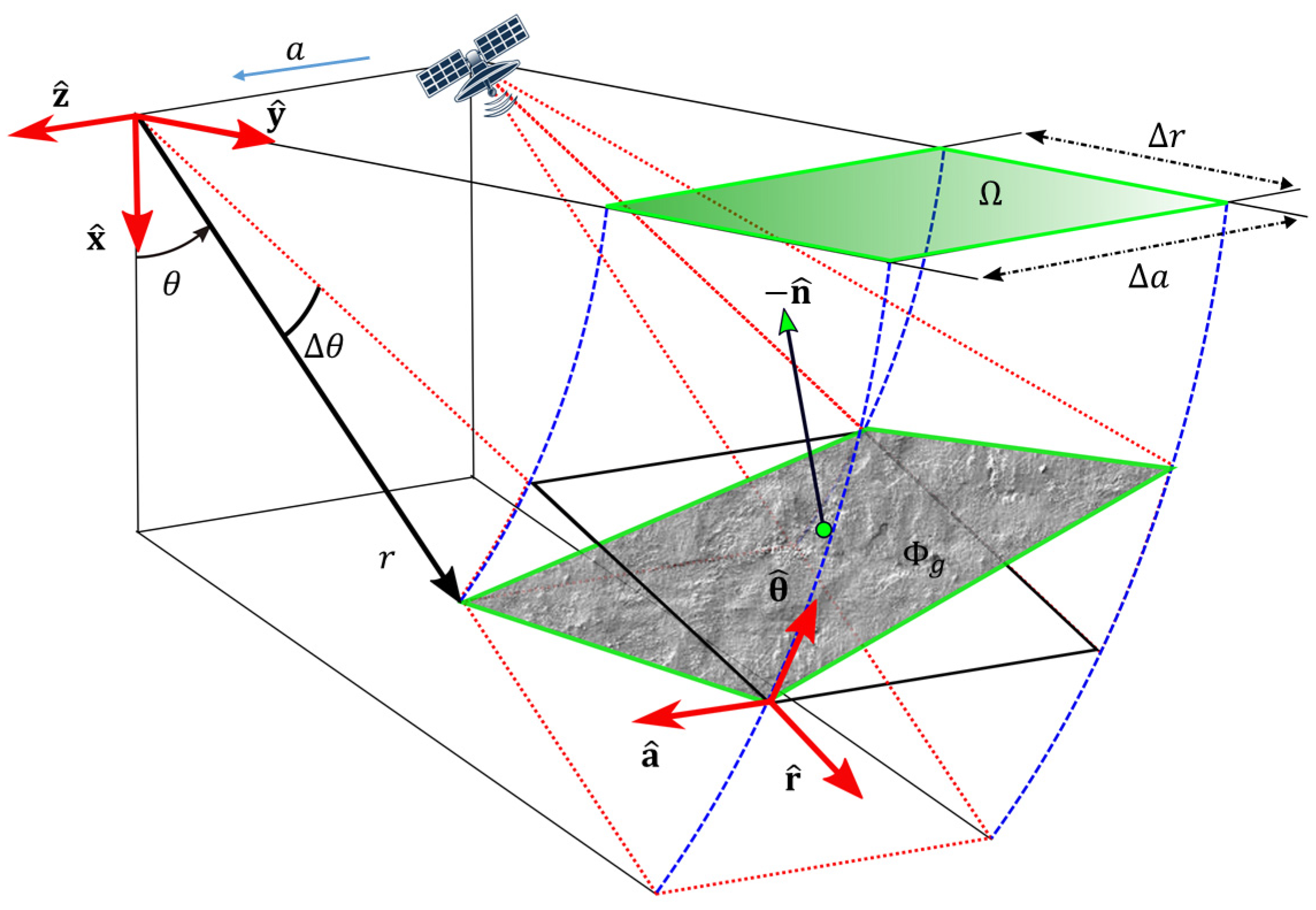
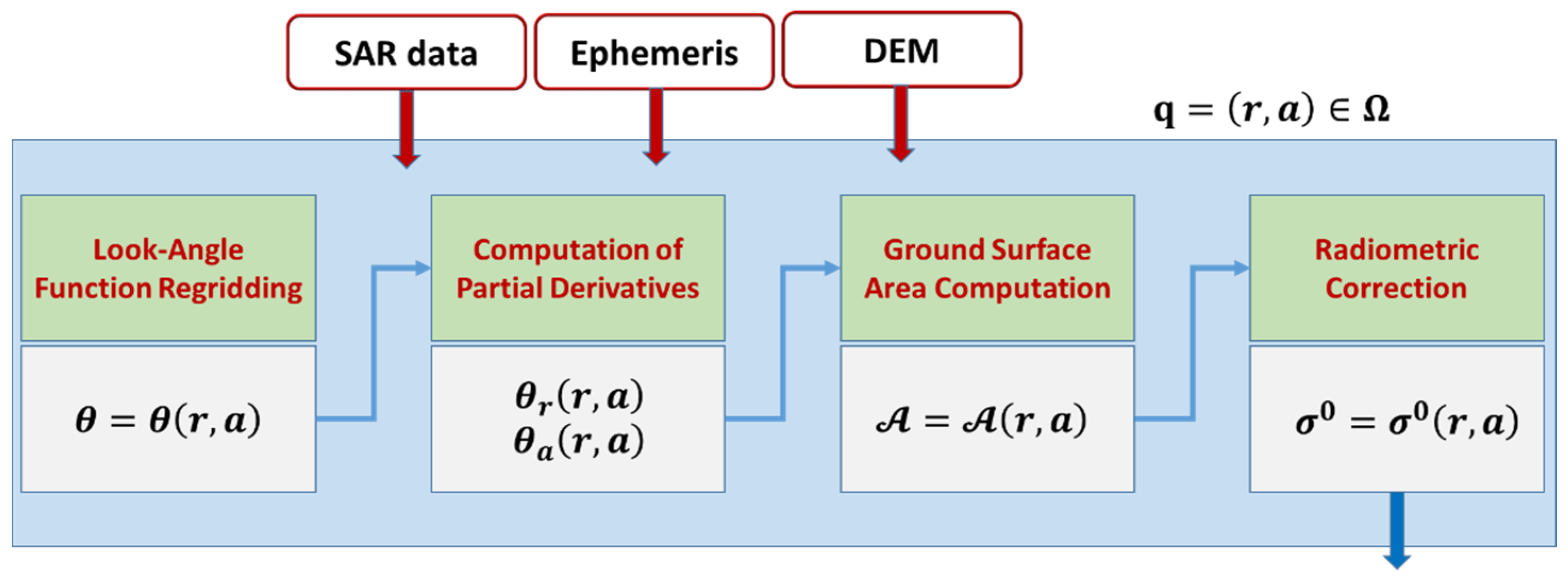
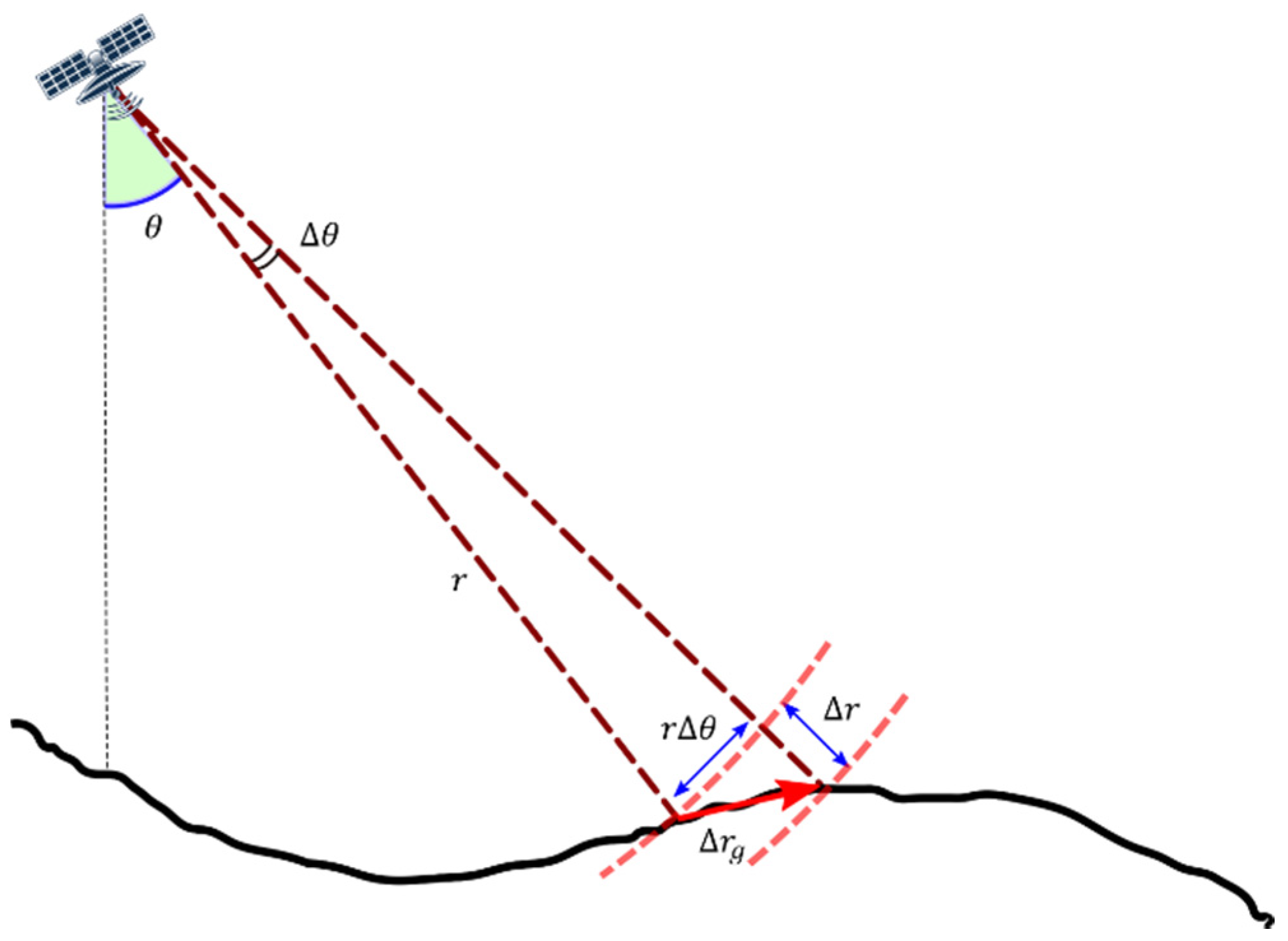
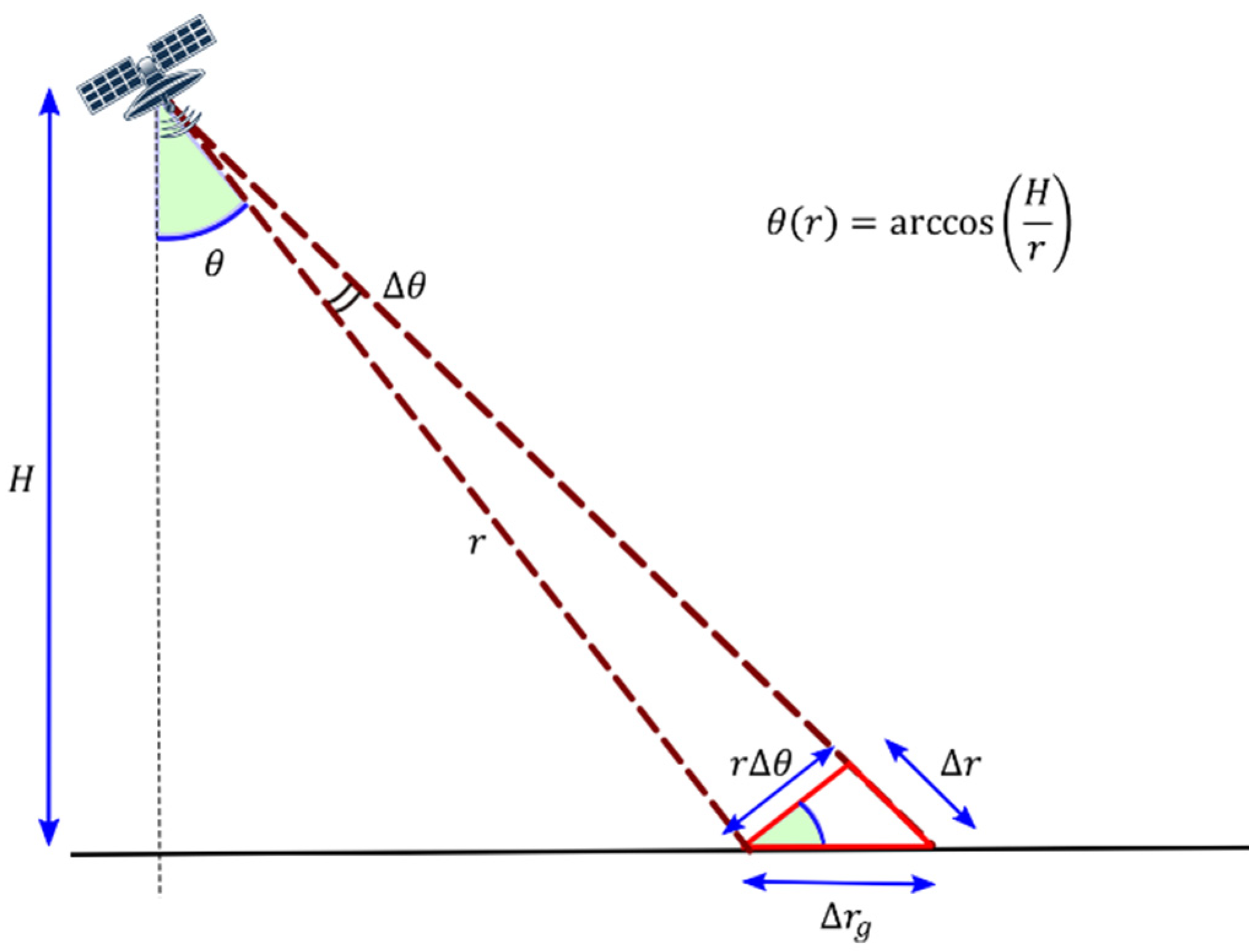
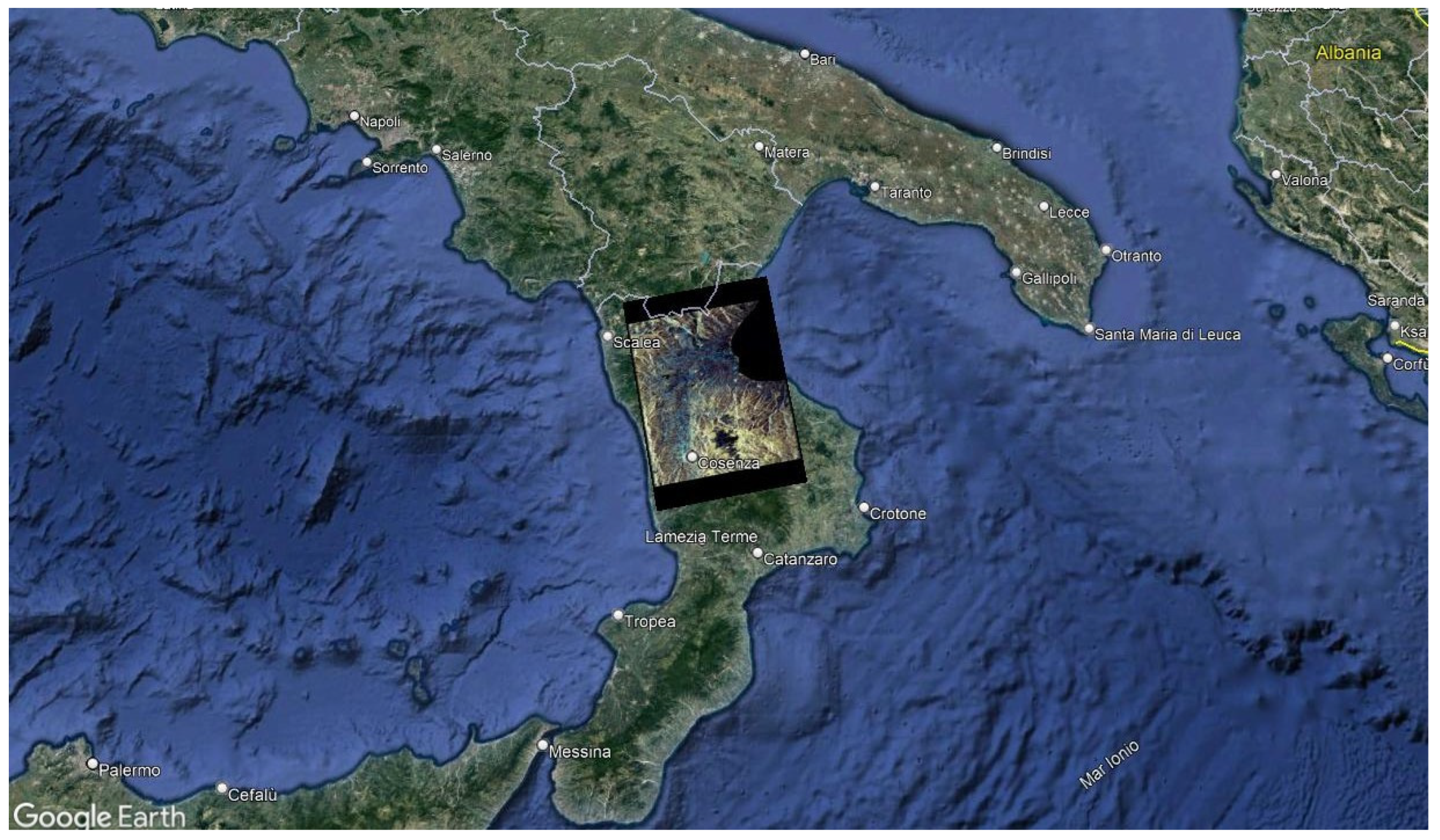
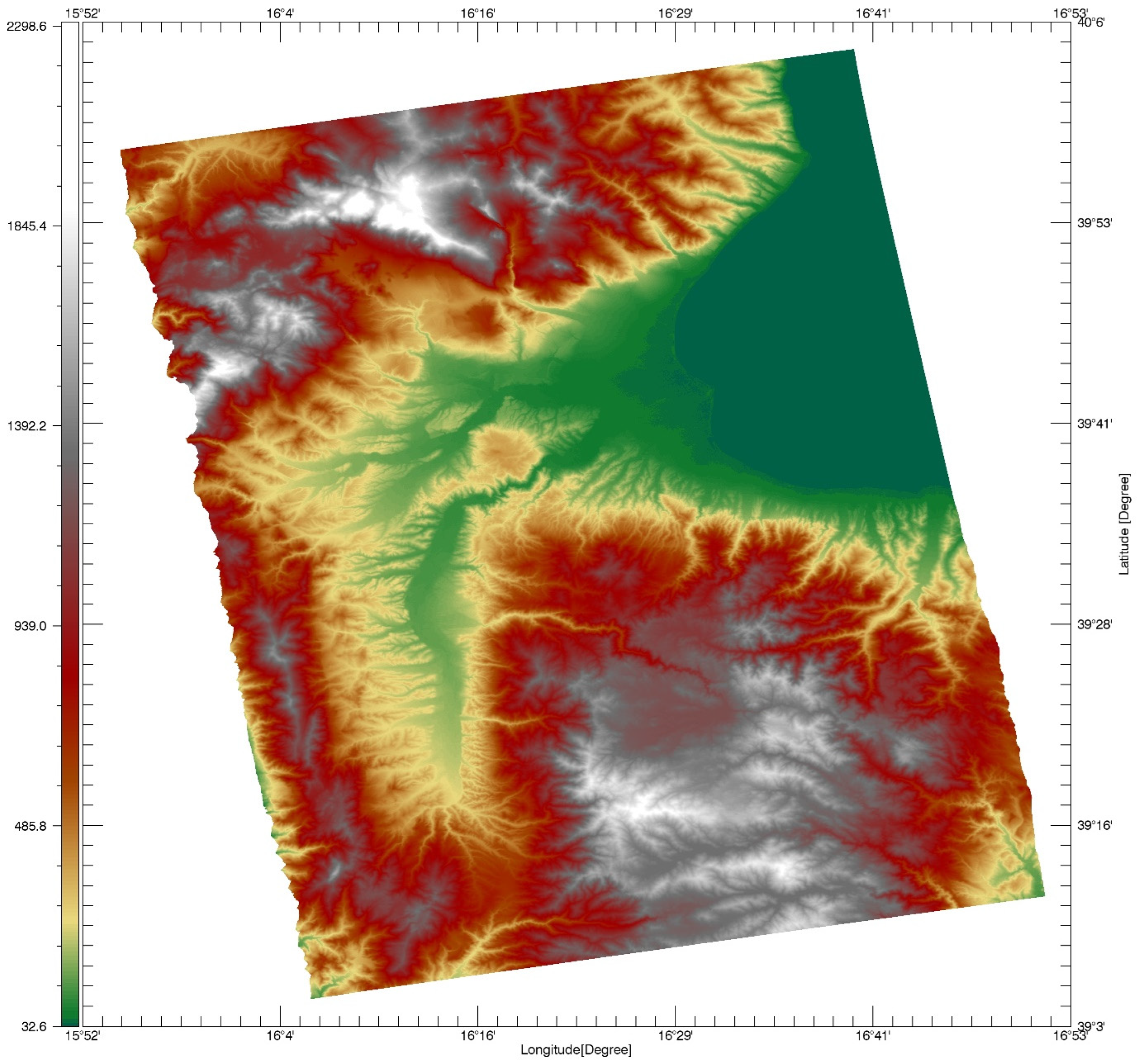



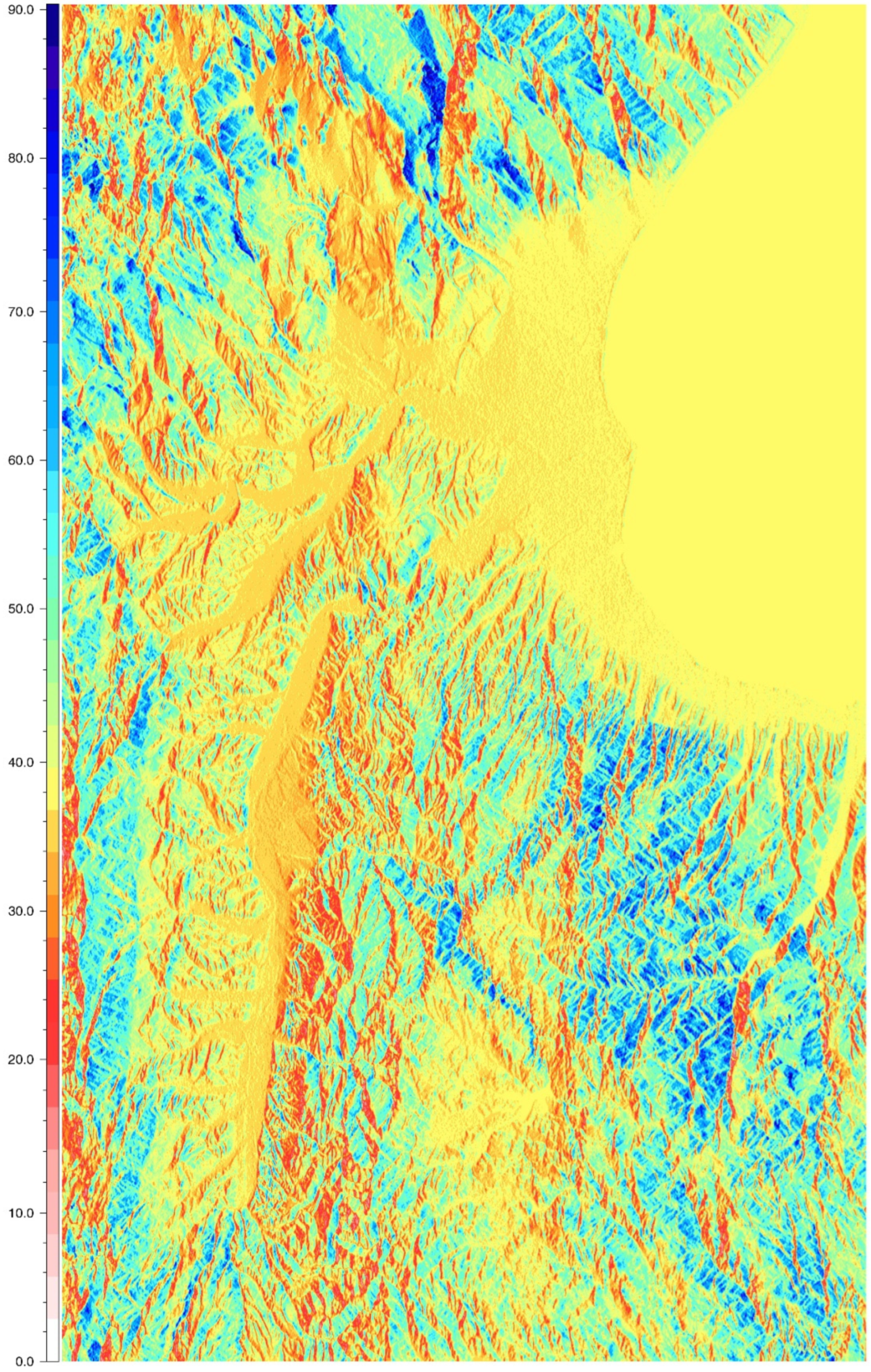
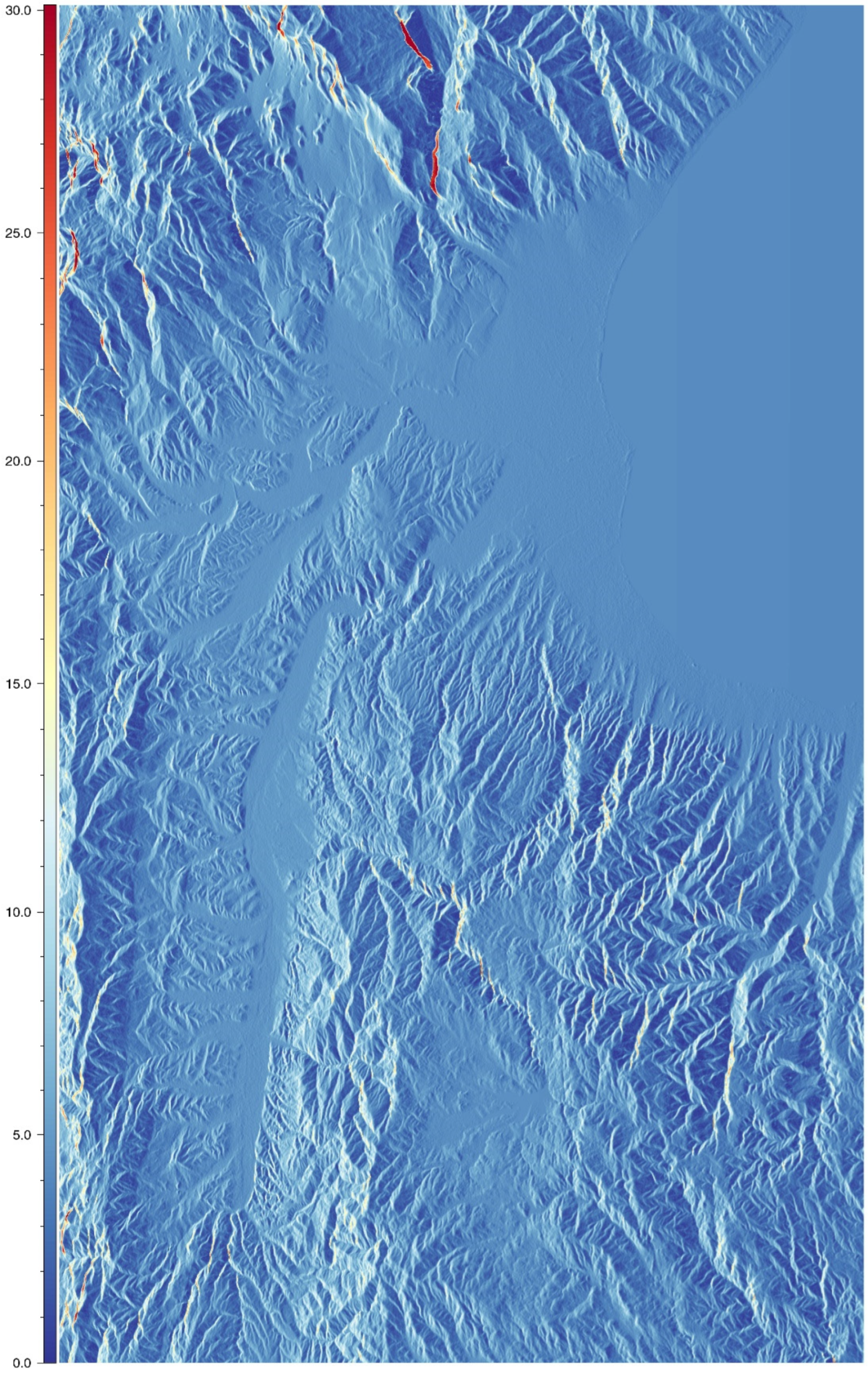
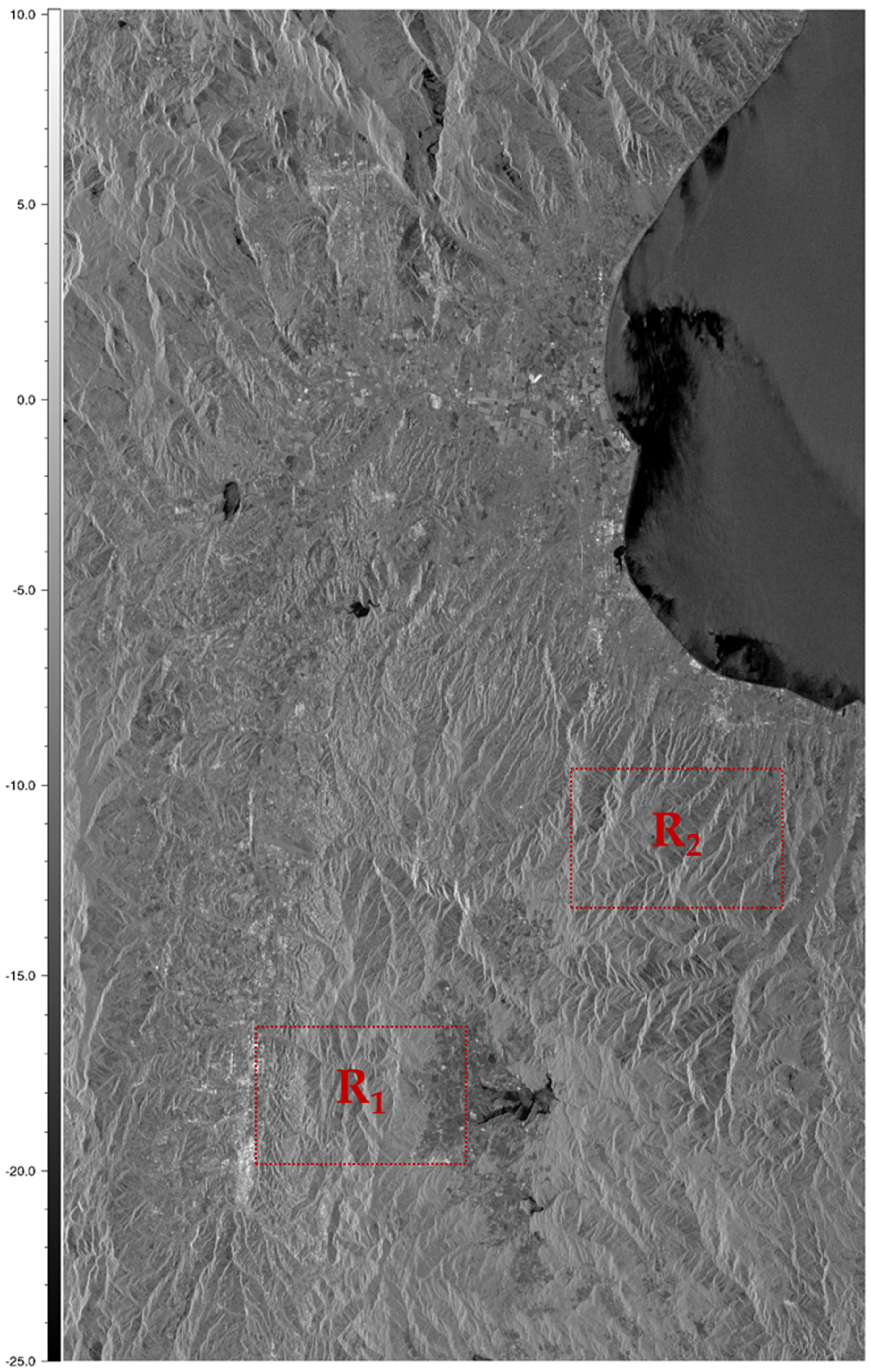
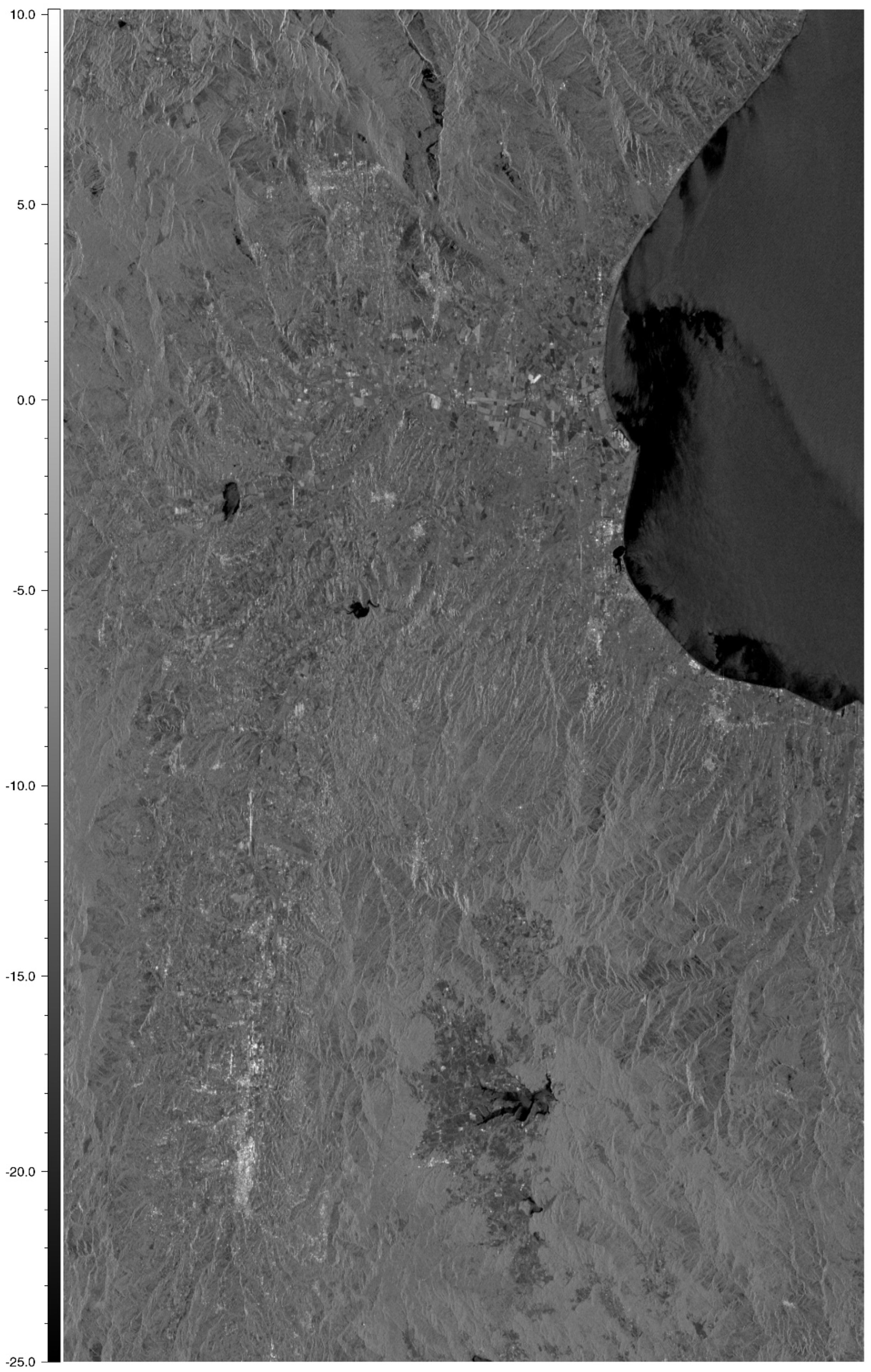
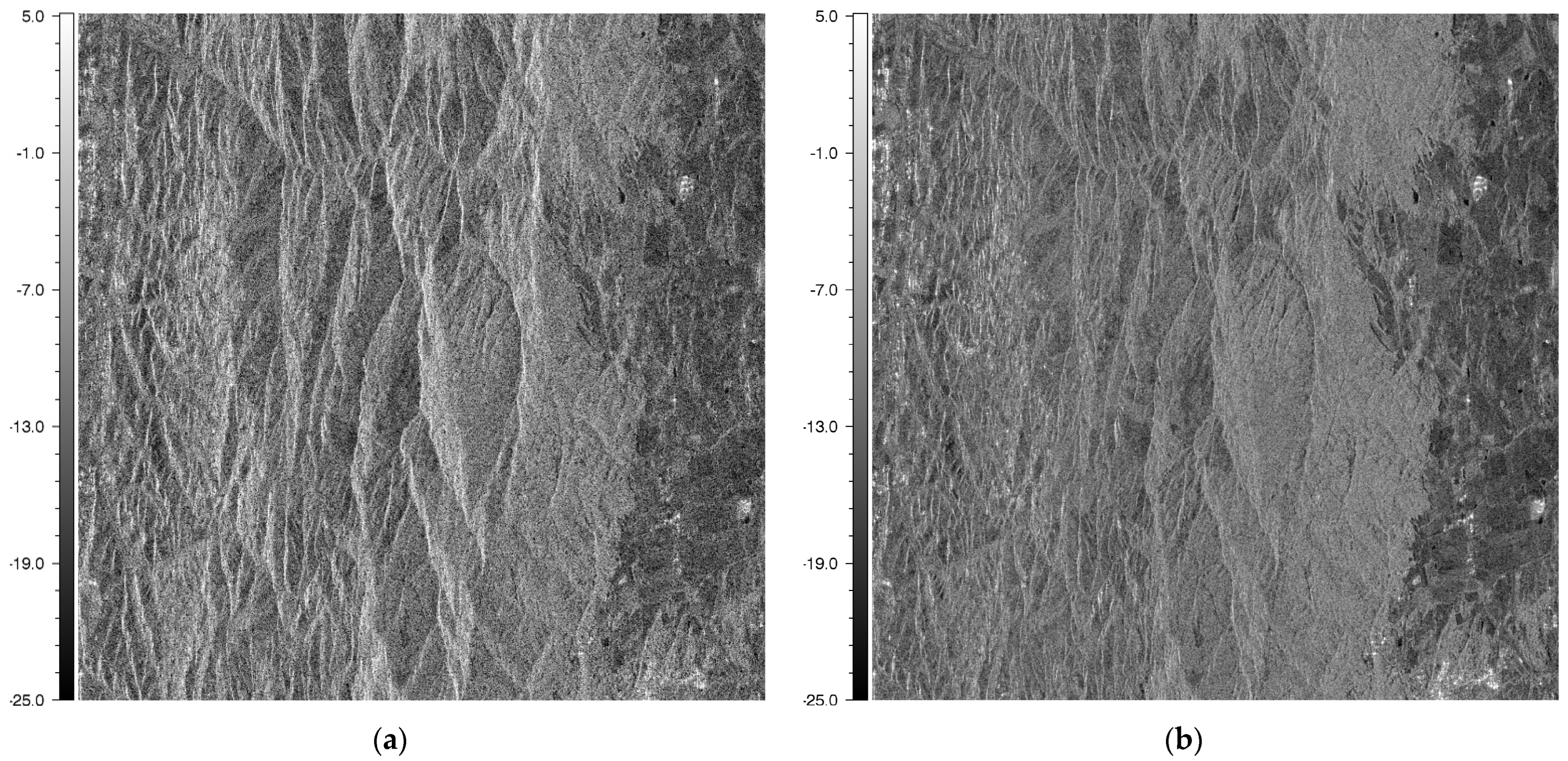
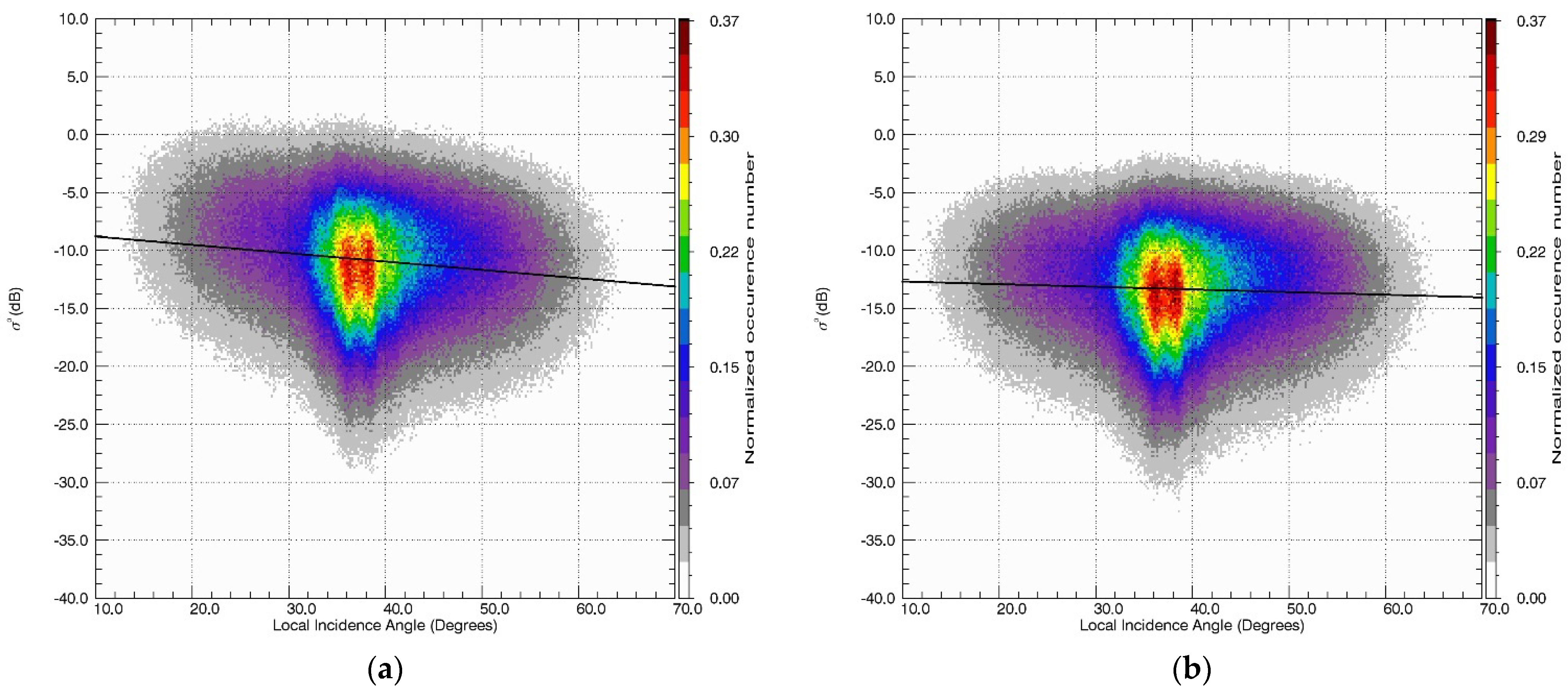
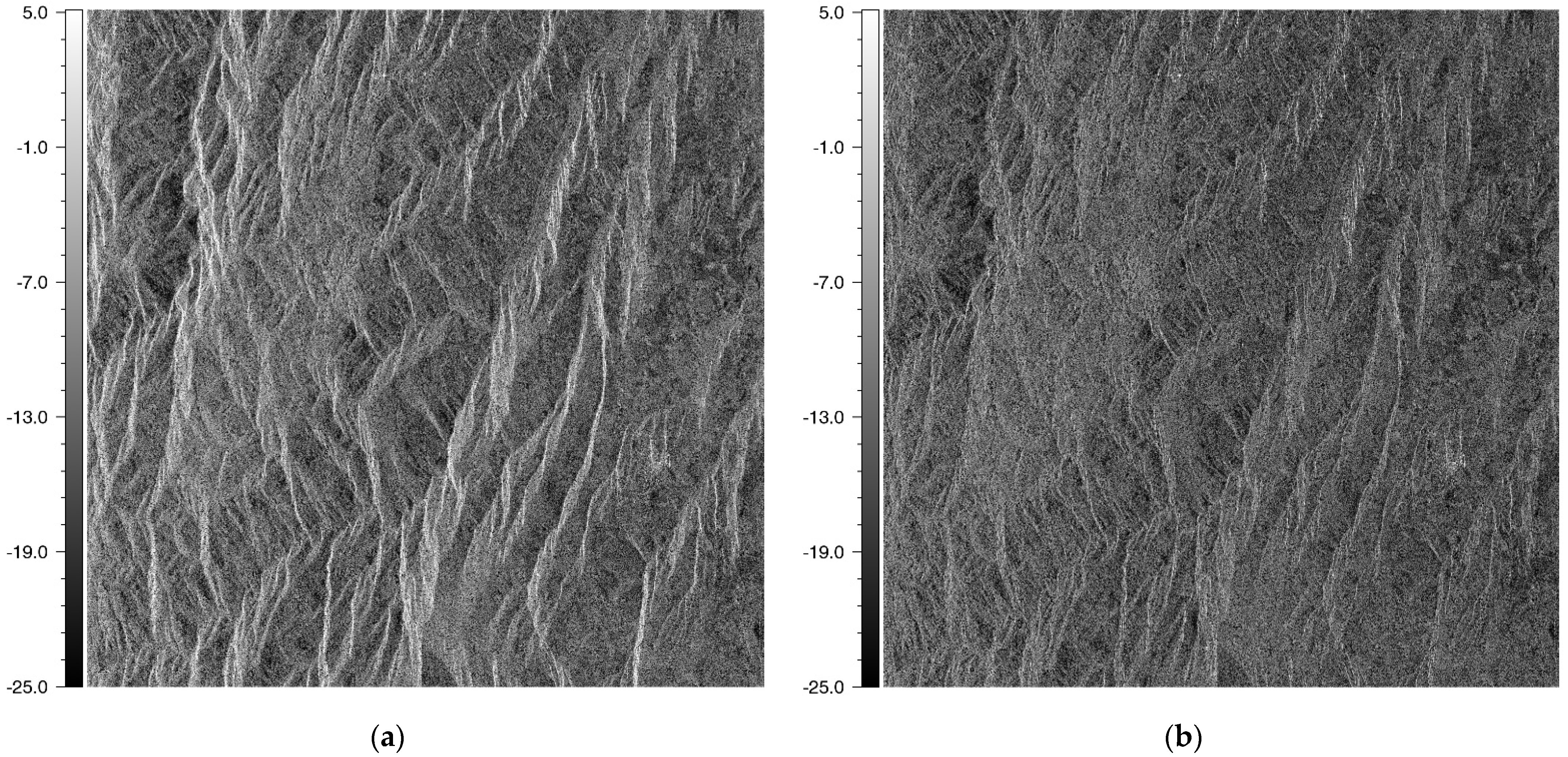
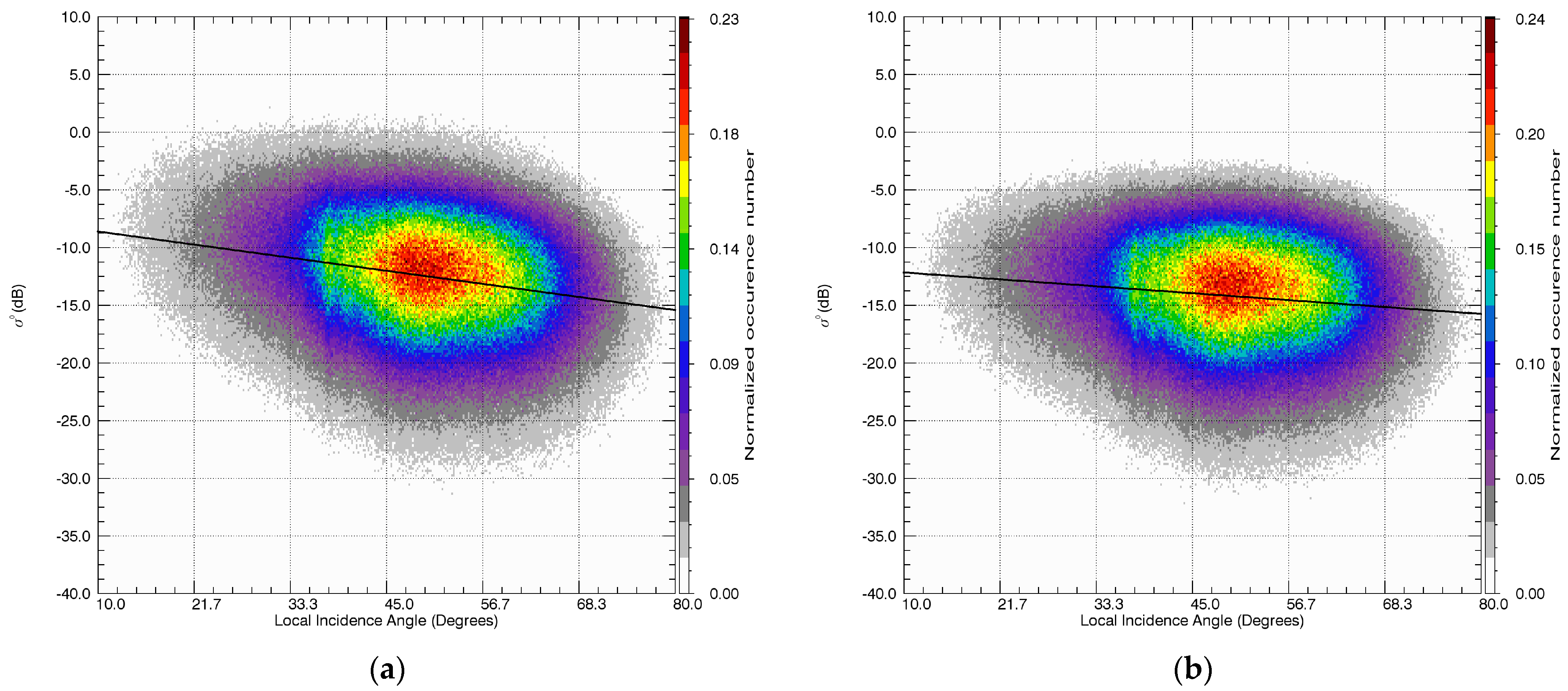
| SAR Platform | SAO1A | |
|---|---|---|
| Acquisition date | 8 October 2021 | |
| Observation direction | Right looking | |
| Polarization | VV + VH | |
| Orbit direction | Ascending | |
| Carrier frequency (GHz) | 1.275 | |
| Off-nadir angle (degree) | 32.2174 | |
| Sampling frequency (MHz) | 30.00 | |
| Chirp bandwidth (MHz) | 24.40 | |
| PRF (Hz) | 1857.00 | |
| Azimuth bandwidth (Hz) | 1229.94 | |
| Azimuth-pixel spacing (m) | 3.74 | |
| Range pixel spacing (m) | 5.00 | |
| Azimuth resolution (m) | 4.99 | |
| Range resolution (m) | 5.42 | |
| Azimuth lines | 26749 | |
| Range samples | 7935 | |
| First near | (latitude (deg), longitude (deg)) | (39.087114, 16.105089) |
| First far | (39.967124, 15.893462) | |
| Last near | (40.074031, 16.669855) | |
| Last far | (39.193983, 16.871278) | |
Disclaimer/Publisher’s Note: The statements, opinions and data contained in all publications are solely those of the individual author(s) and contributor(s) and not of MDPI and/or the editor(s). MDPI and/or the editor(s) disclaim responsibility for any injury to people or property resulting from any ideas, methods, instructions or products referred to in the content. |
© 2023 by the authors. Licensee MDPI, Basel, Switzerland. This article is an open access article distributed under the terms and conditions of the Creative Commons Attribution (CC BY) license (https://creativecommons.org/licenses/by/4.0/).
Share and Cite
Imperatore, P.; Di Martino, G. SAR Radiometric Calibration Based on Differential Geometry: From Theory to Experimentation on SAOCOM Imagery. Remote Sens. 2023, 15, 1286. https://doi.org/10.3390/rs15051286
Imperatore P, Di Martino G. SAR Radiometric Calibration Based on Differential Geometry: From Theory to Experimentation on SAOCOM Imagery. Remote Sensing. 2023; 15(5):1286. https://doi.org/10.3390/rs15051286
Chicago/Turabian StyleImperatore, Pasquale, and Gerardo Di Martino. 2023. "SAR Radiometric Calibration Based on Differential Geometry: From Theory to Experimentation on SAOCOM Imagery" Remote Sensing 15, no. 5: 1286. https://doi.org/10.3390/rs15051286
APA StyleImperatore, P., & Di Martino, G. (2023). SAR Radiometric Calibration Based on Differential Geometry: From Theory to Experimentation on SAOCOM Imagery. Remote Sensing, 15(5), 1286. https://doi.org/10.3390/rs15051286








